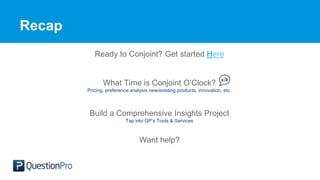QuestionPro Advanced Training Keys to Success - Discrete Conjoint Analysis 101
- 1. DISCRETE CHOICE CONJOINT ANALYSIS 101 April 20th, 2017
- 2. Esther Lavielle Implementation Manager, QuestionPro esther.lavielle@questionpro.com Twitter: @esther_qpro Welcome to the Keys To Success Series #K2SQP By QuestionPro
- 3. Agenda ❏What is Discrete Choice Conjoint Analysis? ❏Do you Conjoint? Why You Should ❏Conjoint O’ Clock - Best Time to Run a Conjoint Study ❏QuestionPro’s 3-in-1 Design Options ❏Best Practices For Discrete Conjoint Project Design ❏Conjoint Analysis FAQs ❏Live Demo: How to Conjoint
- 4. Discrete Choice Conjoint Analysis Trade-off analysis methodology #1 Methodology used research technique for customer purchase decisions For any purchase, consumers evaluate or “trade-off” the different characteristics of a product and decide what is more important to them
- 5. Do You Conjoint? Why You Should New Product Research - Evaluate new products or variations against existing range of products in the marketplace Budget Friendly - Cheaper than developing new products for the marketplace with no guarantee of success Simulates Consumer Decision - Captures how target audience react to new products/services within marketplace -Refine the target audience for your study Real Time Data - Need this data quick? Don’t wait. Get real- time feedback on new products or variations of existing products today Analyze Choice vs. $ - Gauge the effect on the choice/price relationship relative to existing products and features presented
- 6. QuestionPro’s 3-in-1 Design Options Random Design - Most Popular among QP customer - Easy to program - Easy to analyze - Easy to include in comprehensive surveys D-Optimal Design - This algorithm will produce optimal number of tasks per respondent based on sample size to reach statistical significance Import Design Caution* - Available for those who are statistically savvy. Must be able to calculate margin of error from your own design -Externally create conjoint design with custom algorithm & Import into QuestionPro -SPSS Design Format -Fractional Factorial Orthogonal Designs
- 7. Best Time For a Discrete Choice Conjoint Study Business Objective: Market Share Growth New Product/Services Beginning of Innovation Process During Product/Service Planning & Prototyping Cost of Overhead vs. Potential Revenue When you have a Statistically Significant Target Audience
- 8. Best Practices Discrete Choice Conjoint Project Design
- 9. Where to Get Started ● Qualitative Research - Validate Anecdotal Info ● Identify Top Attributes & Levels for research ● Focus group or surveys with open-ended questions will help define your top attributes needed for your study ● Use Crowd-sourcing tools or forums: QuestionPro Communities or IdeaScale ● Define range & language for target audience
- 10. Best Practices ❏ Keep options clear and simple ❏ No more than 20 trade-off exercises ❏ No more than 5-6 attributes ❏ Keep ranges simple ❏ Follow general good online survey techniques ❏ Beta test survey before launch date ❏ Exercise good privacy & confidentiality protocols ❏ Keep survey short & sweet ❏ Provide incentives or rewards $ for long surveys
- 11. Best Practices for Sample Size ❏ Sample size recommendation: (nta/C) > 1000 n = number of respondents x t= number of tasks x a= number of alternatives per task / C= largest number of level for any one attribute. ❏ Example: 500 respondents, 3 tasks per respondent, 2 alternatives per task and the maximum number of levels on an attribute is 3 (500 x 3 x 2) / 3 = 1000 ❏ Generally speaking sample sizes tend to be around 200 – 1200 respondents, admittedly a wide range ❏ 300 comes up most often for a single homogeneous group of subjects
- 13. 4 Discrete Choice Conjoint Reporting Options Attribute Importance Market Share Simulation - Shows how much consumers are willing to spend for each feature they’re considering adding to their brand - Part worth also show if consumers are willing to exchange one feature for another - Simulate market share potentials based on insights collected - Customized based on set features & attributes
- 14. Profile Analysis Brand Premium - Highlights Best vs Worst - Customize Profile Output - Allows you to see what was shown to each respondent - Measure Potential Price Elasticity - Based on Features & insights collected 4 Discrete Choice Conjoint Reporting Options
- 15. The Analytics How do we come up with our numbers for Parts Worth Calculations? QuestionPro’s Discrete Choice Module uses a Maximum Likelihood calculation coupled with a Nelder-Mead Simplex algorithm Have greater confidence in the results you receive!
- 16. What’s the Market Segment Simulator Going to Tell Me? Market Segment Simulator gives ability to "predict" market share of new products and concepts that may not exist now ● Measure the "Gain" or "Loss" in market share based on changes to existing products in the given market Conjoint Simulation Rulebook Identify “Profiles” - different products or concepts to investigate Review existing products in current market segment & simulate market share of the products to establish a baseline Try out new services and ideas. See how the market share shifts based on different products and configurations from data collected
- 17. Build it Now How To Conjoint
- 18. Recap Ready to Conjoint? Get started Here What Time is Conjoint O’Clock? Pricing, preference analysis new/existing products, innovation, etc. Build a Comprehensive Insights Project Tap into QP’s Tools & Services Want help?
- 19. Thank You! Questions? Want to talk Conjoint? sales@questionpro.com Tell me what you want to learn esther.lavielle@questionpro.com Twitter: @esther_qpro #K2SQP #ConjointOClockQP
Editor's Notes
- Segmentation analysis of Gender/Age Most frequently used for consumer-based insights Rarely seen in B2B insights


















